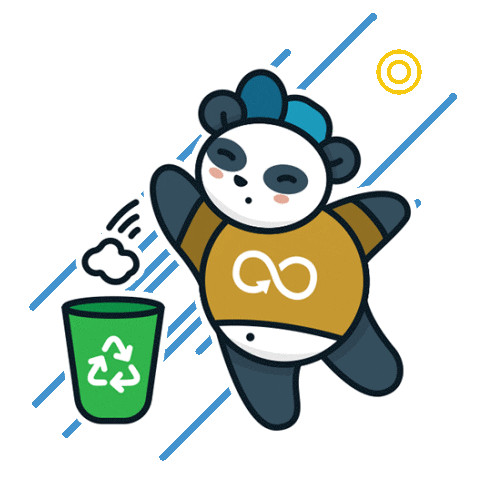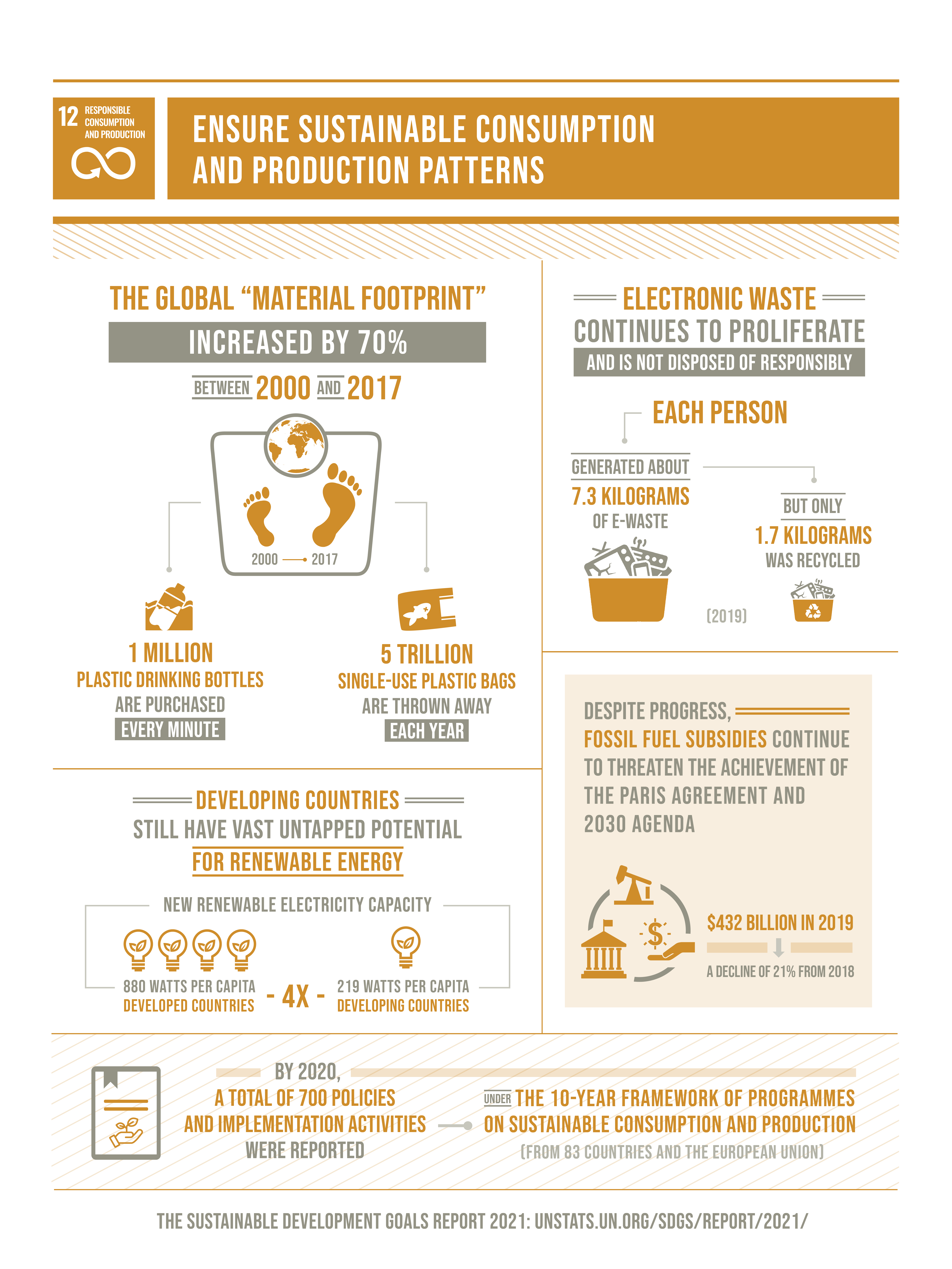



Economic and social progress over the last century has been accompanied by environmental degradation that is endangering the very systems on which our future development — indeed, our very survival — depends.
The COVID-19 pandemic offers countries an opportunity to build recovery plans that will reverse current trends and change our consumption and production patterns towards a more sustainable future.
Sustainable consumption and production is about doing more and better with less. It is also about decoupling economic growth from environmental degradation, increasing resource efficiency and promoting sustainable lifestyles.
Sustainable consumption and production can also contribute substantially to poverty alleviation and the transition towards low-carbon and green economies.
12.1 Implement the 10-year framework of programmes on sustainable consumption and production, all countries taking action, with developed countries taking the lead, taking into account the development and capabilities of developing countries
12.2 By 2030, achieve the sustainable management and efficient use of natural resources
12.3 By 2030, halve per capita global food waste at the retail and consumer levels and reduce food losses along production and supply chains, including post-harvest losses
12.4 By 2020, achieve the environmentally sound management of chemicals and all wastes throughout their life cycle, in accordance with agreed international frameworks, and significantly reduce their release to air, water and soil in order to minimize their adverse impacts on human health and the environment
12.5 By 2030, substantially reduce waste generation through prevention, reduction, recycling and reuse
12.6 Encourage companies, especially large and transnational companies, to adopt sustainable practices and to integrate sustainability information into their reporting cycle
12.7 Promote public procurement practices that are sustainable, in accordance with national policies and priorities
12.8 By 2030, ensure that people everywhere have the relevant information and awareness for sustainable development and lifestyles in harmony with nature
12.A Support developing countries to strengthen their scientific and technological capacity to move towards more sustainable patterns of consumption and production
12.B Develop and implement tools to monitor sustainable development impacts for sustainable tourism that creates jobs and promotes local culture and products
12.C Rationalize inefficient fossil-fuel subsidies that encourage wasteful consumption by removing market distortions, in accordance with national circumstances, including by restructuring taxation and phasing out those harmful subsidies, where they exist, to reflect their environmental impacts, taking fully into account the specific needs and conditions of developing countries and minimizing the possible adverse impacts on their development in a manner that protects the poor and the affected communities
For decades, scientists have been explaining the ways in which humanity is driving the three planetary crises of climate, biodiversity and pollution, all of which are linked to unsustainable production and consumption. Changes in consumption and production patterns can help to promote the decoupling of economic growth and human well-being from resource use and environmental impact. They can also trigger the transformations envisaged in global commitments on biodiversity, the climate, and sustainable development in general. The COVID-19 pandemic provides a window of opportunity for exploring more inclusive and equitable development models that are underpinned by sustainable consumption and production.
From 2017 to 2020, 83 countries, territories and the European Union shared information on their contribution to the implementation of the 10-Year Framework of Programmes on Sustainable Consumption and Production Patterns. In 2020, 136 policies and 27 implementation activities were reported, bringing the total number to over 700. While specific actions have been taken to improve resource use efficiency in a specific industry or area, this has not resulted in their widespread adoption across sectors and industries.
Data indicate a rise of almost 40 per cent in the global material footprint per capita, from 8.8 metric tons in 2000 to 12.2 metric tons in 2017. Similarly, domestic material consumption per capita increased by more than 40 per cent, from 8.7 metric tons in 2000 to 12.2 metric tons in 2017.
Although limited data are available, as of 2016, almost 14 per cent of food produced globally was lost before reaching the retail sector. Estimates vary across regions, from 20.7 per cent in Central and Southern Asia to 5.8 per cent in Australia and New Zealand.
In 2019, the amount of e-waste generated was 7.3 kg per capita, with only 1.7 kg per capita documented to be managed in an environmentally sustainable manner. E-waste generation is expected to grow by 0.16 kg per capita annually to reach 9 kg per capita in 2030. The annual rate of growth in e-waste recycling over the past decade was 0.05 kg per capita, which will need to increase more than tenfold if all e-waste is to be recycled by 2030.
A pilot review conducted in 2020 on a random sample of about 4,000 companies in the United Nations Global Compact database and the Sustainability Disclosure database of the Global Reporting Initiative indicates that 85 per cent of companies reported on minimum requirements for sustainability issues and 40 per cent on advanced requirements for such issues.
As of December 2020, 40 countries and territories had reported on sustainable public procurement policies and action plans or equivalent legal dispositions aimed at encouraging the procurement of environmentally sound, energy-efficient products and promoting more socially responsible purchasing practices and sustainable supply chains.
Fossil fuel subsidies declined in 2019 to $431.6 billion as a result of lower fuel prices, reversing the upward trend from 2017 to 2018. Fossil fuel subsidies are expected to fall sharply owing to the collapse in demand caused by COVID-19 mitigation efforts and the oil price shock experienced in 2020.
There are many aspects of consumption that with simple changes can have a big impact on society as a whole. For example, the global material footprint – an indicator of the pressure put on the environment to support economic growth and to satisfy the material needs of people – grew by 17.4 per cent to 85.9 billion metric tons in 2017 as compared to 2010. Reducing food loss and waste can contribute to environmental sustainability by lowering production costs and increasing the efficiency of food systems. Currently, we lose 13.8 per cent after harvesting and during transport, storage and processing alone, amounting to a cost of over $400 billion a year. We are also polluting water faster than nature can recycle and purify water in rivers and lakes.
It’s in businesses’ interest to find new solutions that enable sustainable consumption and production patterns. A better understanding of environmental and social impacts of products and services is needed, both of product life cycles and how these are affected by use within lifestyles. Identifying “hot spots” within the value chain where interventions have the greatest potential to improve the environmental and social impact of the system as a whole is a crucial first step. Innovation and design solutions can both enable and inspire individuals to lead more sustainable lifestyles, reducing impacts and improving well-being.
There are two main ways to help:
Making informed purchases also helps. For example, the textile industry today is the second largest polluter of clean water after agriculture, and many fashion companies exploit textile workers in the developing world. If you can buy from sustainable and local sources you can make a difference as well as exercising pressure on businesses to adopt sustainable practices.
[Source:- www.un.org]